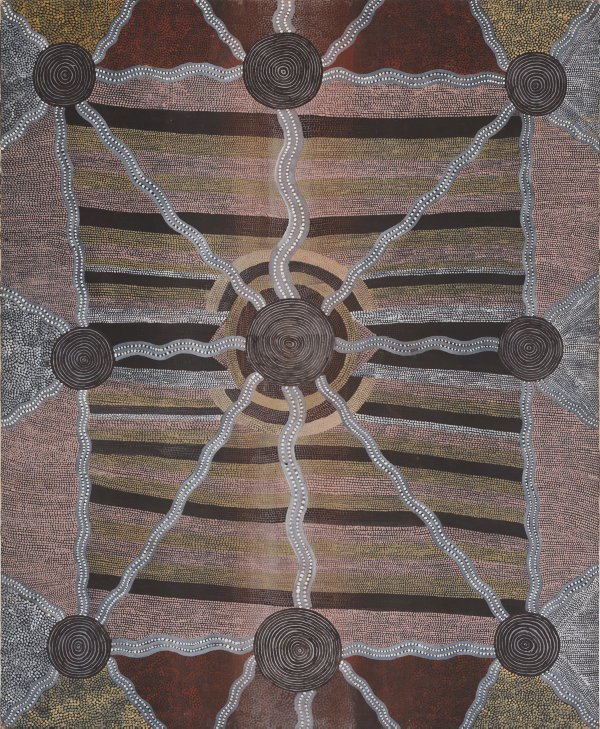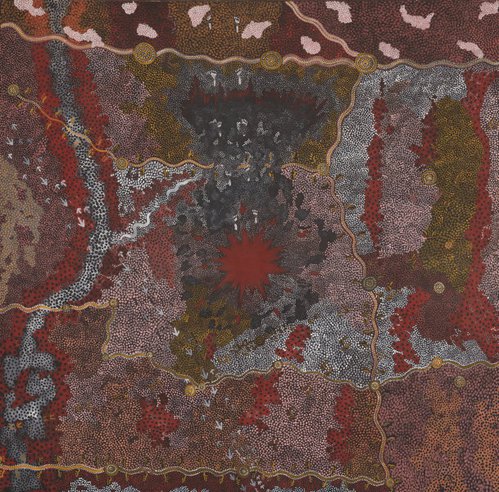Title
Kooralia
1980
Artist
-
Details
- Place where the work was made
-
Papunya
→
Northern Territory
→
Australia
- Cultural origin
- Papunya Tula Movement
- Date
- 1980
- Media category
- Painting
- Materials used
- synthetic polymer paint on canvas
- Dimensions
- 187.0 x 154.0 x 2.3 cm stretcher
- Signature & date
Not signed. Not dated.
- Credit
- Gift of the Art Gallery Society of New South Wales 1995
- Location
- North Building, ground level, Yiribana Gallery
- Accession number
- 482.1995
- Copyright
- © Estate of Tim Leura Tjapaltjarri. Licensed by Aboriginal Artists Agency Ltd
- Artist information
-
Tim Leura Tjapaltjarri
Works in the collection
- Share
-
-
About
Tim Leura Tjapaltjarri was born in Napperby Creek and grew up around Napperby Station, around 200 kilometres north west of Mparntwe (Alice Springs), in his traditional Anmatyerr country. After working at Narwietooma Station as a stockman, he moved to Papunya in the late 1950s with his wife Daisy Leura Nakamarra and their young family, when the construction programme for the new settlement began.
Tjapaltjarri was already known in Central Australia as a brilliant craftsman in wood before the painting movement began in Papunya in 1971. He presented himself to schoolteacher Geoffrey Bardon and asked to do a painting. The two men became friends, and TjapaItjarri went on to play a leading role in the emerging Papunya painting enterprise. Bardon recalls Tjapaltjarri encouraging his younger brother, Clifford Possum Tjapaltjarri (their mothers were sisters), to join the 'painting mob'. They went on to collaborate on some of the landmark paintings of the era, most notably the 1976 work, 'Warlugulong'.
In the mid-1970s, Tim Leura Tjapaltjarri served on the Aboriginal Arts Board of the Australia Council as a Papunya Tula representative.
Bardon's book, 'Papunya Tula: Art of the Western Desert' contains a detailed map drawn by Tjapaltjarri. It shows his country and the sacred sites of the Rrpwamper (possum), Anek (yam), Rwang (fire), Lhwelk (blue-tongue lizard), Atwern (sun), Atay (moon) and Morning Star and other Tjukurrpa. Tjapaltjarri's paintings were often sombre in both colour and content, which some observers believe reflected the artist's profound sadness at the loss of the old ways of living. However, Dick Kimber, who knew Tjapaltjarri over a long period, contends that it was '... more a deep sense of family attachment, and strong recall of his father and grandfather and their association with the country'.
The bold heraldic design of 'Kooralia', 1980, is in some ways atypical, but its subtle evocation of a moonbeam failing across the striped sands of the Napperby Creek bed exemplifies the artist's interest in atmospherics, particularly night effects.
Despite a painting career cut short by his untimely death, the paintings of Tjapaltjarri remain a telling influence on the work of many Western Desert artists.
Vivien Johnson in 'Tradition today: Indigenous art in Australia', Art Gallery of New South Wales, Sydney, 2004
© Art Gallery of New South Wales
-
Places
Where the work was made
Papunya
-
Exhibition history
Shown in 11 exhibitions
Painted Dreams, Art Gallery of New South Wales, Sydney, 1982–1982
Face of the Centre (1985), National Gallery of Victoria [St Kilda Road], Melbourne, 1985–1985
Copyrites - Aboriginal Art in the Age of Reproductive Technology, Cairns Art Gallery, Cairns, 02 Feb 1996–03 Mar 1996
Copyrites - Aboriginal Art in the Age of Reproductive Technology, Northern Territory Museum of Arts & Sciences, Australia, 15 Mar 1996–07 Apr 1996
Copyrites - Aboriginal Art in the Age of Reproductive Technology, Araluen Arts Centre, Alice Springs, 26 Apr 1996–26 May 1996
Copyrites - Aboriginal Art in the Age of Reproductive Technology, Tandanya, Adelaide, 07 Jun 1996–07 Jul 1996
Copyrites - Aboriginal Art in the Age of Reproductive Technology, Broken Hill City Art Gallery, Broken Hill, 16 Jul 1996–11 Aug 1996
Copyrites - Aboriginal Art in the Age of Reproductive Technology, Art Gallery of New South Wales, Sydney, 21 Aug 1996–10 Nov 1996
Spirit and place: art in Australia 1861-1996, Museum of Contemporary Art, Australia, 21 Nov 1996–31 Mar 1997
Papunya Tula: Genesis and Genius, Art Gallery of New South Wales, Sydney, 18 Aug 2000–12 Nov 2000
One sun, one moon, Art Gallery of New South Wales, Sydney, 03 Jul 2007–02 Dec 2007
Country Culture Community (2008-09), Art Gallery of New South Wales, Sydney, 12 Nov 2008–19 Apr 2009
Great collections (2009), Campbelltown Arts Centre, Campbelltown, 12 Dec 2008–18 Jan 2009
Great collections (2009), Tweed Regional Gallery & Margaret Olley Art Centre, Murwillumbah, 06 Feb 2009–15 Mar 2009
Great collections (2009), Western Plains Cultural Centre, Dubbo, 03 Apr 2009–10 May 2009
Great collections (2009), Albury Regional Gallery, Albury, 29 May 2009–05 Jul 2009
Great collections (2009), Art Gallery of Ballarat, Ballarat, 24 Jul 2009–30 Aug 2009
Our spirits lie in the water, Art Gallery of New South Wales, Sydney, 15 Nov 2014–01 Nov 2015
Yiribana Gallery: opening collection display, Art Gallery of New South Wales, North Building, Sydney, 03 Dec 2022–29 May 2023
Papunya Tula Artists (1988), Wagga Wagga Art Gallery, Australia
-
Bibliography
Referenced in 14 publications
-
Edmund Capon AM, OBE, Steven Miller, Tony Tuckson, James Scougall, Mollie Gowing, Harry Messel, Craig Brush, Ronald Fine, Alison Fine, Gordon Davies, Rosalind Davies, Christopher Hodges, Helen Eager, Rosemary Gow, Sandra Phillips, Daphne Wallace and Ken Watson, Gamarada, Sydney, 1996, 70.
-
Jonathan Cooper (Editor), The Art Gallery of New South Wales Bulletin, 'Yiribana Aboriginal & Torres Strait Islander Gallery', pg. 26-29, Sydney, Aug 1996-Oct 1996, 26 (colour illus.).
-
Hetti Perkins, Education Kit - Papunya Tula: genesis and genius, 'Anmatyerre icons', pg. 6, Sydney, 2000, 6 (colour illus.).
-
Marie Geissler, Dreaming the Land, 2022, 274, 276 (colour illus.).
-
Bruce James, Art Gallery of New South Wales handbook, 'Australian Collection: Aboriginal and Torres Strait Islander Art', pg. 208-241, Sydney, 1999, 222 (colour illus.).
-
Vivien Johnson, Copyrites - Aboriginal Art in the Age of Reproductive Technologies, Sydney, 1996, 42 (colour illus.), 54.
-
Vivien Johnson, Tradition today: Indigenous art in Australia, 'Tim Leura Tjapaltjarri', pg. 150, Sydney, 2004, 150, 151 (colour illus.).
-
Vivien Johnson, Painted Dreams, 'Collecting Western Desert Art - a personal view', pg. 8-13, Sydney, 1995, 8, 14 (colour illus.), 15 (colour illus.), 46. plate no. 1
-
John McPhee, Great collections, Sydney, 2008, 115 (colour illus.).
-
Ross Mellick and Nick Waterlow, Spirit and place: Art in Australia 1861-1996, Sydney, Nov 1996, 148.
-
Hetti Perkins and Hannah Fink, One sun one moon: Aboriginal art in Australia, ‘Genesis and genius: The art of Papunya Tula artists’, pg. 181-188, Sydney, 2007, 187 (colour illus.).
-
Hetti Perkins and Ken Watson, Aboriginal art collections: highlights from Australia's public museums and galleries, 'Art Gallery of New South Wales, Sydney', pg. 40-45, Sydney, 2001, 42 (colour illus.). plate no. 23
-
Hetti Perkins and Hannah Fink (Editors), Papunya Tula: genesis and genius, Sydney, 2000, 79 (colour illus.), 286. no catalogue number
-
Hetti Perkins and Hannah Fink, Art and Australia (Vol. 38, No. 1), 'Covering ground: the corporeality of landscape', pg. 74-83, Sydney, Sep 2000-Nov 2000, 78 (colour illus.).
-

